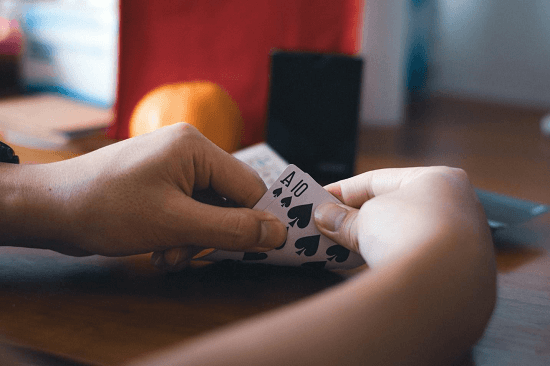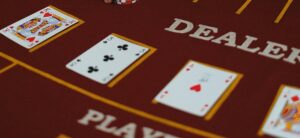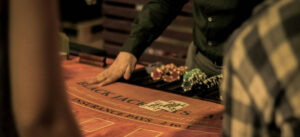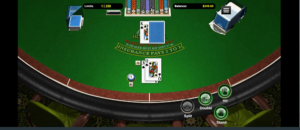Blackjack 21 Rules

Blackjack 21 (otherwise simply known as “blackjack”) might be the world’s most popular casino game, beating out the likes of roulette and baccarat.
While it’s a very simple game to play, there are some strategies that you should know about to give you the best possible chance of beating the dealer.
In its simplest form, the aim of blackjack is to get a hand as close as possible to 21 without going over 21. At the same time, you’ll be aiming for a hand that’s closer to 21 than the dealer’s hand.
While it might sound like all of that is up to chance, you’ll need to know when to stand, when to hit, and when your cards mean you’ve just gone bust. If all that terminology sounds too confusing, we’ll break it down in our full guide to the blackjack 21 rules.
What Is Blackjack?
When you think of playing blackjack, you might imagine high rollers in a high-end casino, but the game’s journey dates back much further than recent history. In fact, blackjack has been around for more than 300 years.
If you look into the history of blackjack, you’ll find that it’s based on olden-day French and Italian card games, when a variation called “vingt-un” was a favourite pastime of King Louis XV’s crowd.
The term “blackjack” was first coined at the turn of the 20th century, but the game gained traction around World War I. Ever since, it’s been a staple at land-based and online casinos alike.
There are two significant people in blackjack – the player (that’s you) and the dealer. In a land-based casino, you and your tablemates would sit down with the dealer to play, but when you’re gambling online, the dealer usually takes the form of a computer (unless you’re playing live dealer blackjack).
The aim of blackjack is to get a hand as close as possible to 21, without exceeding 21, and to do this; you can apply some basic strategies, which we’ll go into detail about a little later in our guide.
How to Play 21 Card Game
The rules of blackjack are easy to understand, but you need to make sure you’re familiar with them so that you’re not just playing each hand randomly.
Once you’ve sat at the virtual table, you’ll be given some time to place your bets before the dealer hands out the cards. You and your fellow players (if you’re playing live dealer blackjack 21) will each be dealt two cards face up while the dealer gets two cards, but only one is face up.
If your two cards add up to a total of 21, that’s “blackjack”, and you win. If your hand comes to less than 21, you can decide if you want to “hit” (continue drawing cards) or “stand” (hold on to what you have).
If you have a pair, you can also decide to split your hand, which means you can divide your hand into two and place a new bet at the same cost as your original stake. If you’re confident in your hand, you might also want to double your bet for a chance at a bigger win.
The most important thing is that you don’t let your hand go over 21 because if it does, you’ll go bust, which means your bet loses immediately.
When you’re playing blackjack 21 at online casinos, it’s important to keep in mind that you might find some games (for example live dealer tables) where the rules are slightly different.
For example, some tables allow you to place special side bets, while others have unique and interactive features like lightning cards that can award multipliers. If you’re not sure about the rules of a specific blackjack game, have a quick look at the game info before you start playing.
The Value of Cards

When you’re playing blackjack 21, it’s handy to know all the card values off by heart, so that you can make swift decisions about your next move. The card values are pretty straightforward, but we’ll list them all in a table below to make it even easier to understand.
| Card | Value |
| 2 – 10 | Face value |
| Jack, King, Queen | 10 |
| Ace | 11 or one |
The only card whose value doesn’t stay constant is the ace, and you can decide whether to count it as 11 or one.
The value of the cards will be added together to determine the total of your hand so for example, if you’re dealt a seven and an eight, your total will be 15. That’s below 21, so you won’t go bust and can continue.
If you then go on to draw a six, you’ll have reached 21, and you’ll have a winning hand. But if you draw a seven, your total will be 22, so you’ll be bust.
Card Combinations
The number of possible card combinations in blackjack 21 is 1,326 with a single deck, or 5,356 for a two-deck game, but a few combinations might interest you.
If you get an ace and a ten or any picture card in your original hand, your total will come to 21, which is what’s called “blackjack”. This is an immediate win, and you’ll get a 3:2 payout unless the dealer has also been lucky enough to draw blackjack.
If you go on to draw more cards after your first two, you can still make a hand of 21, but in that case, it’s not called blackjack.
A soft hand is when you get an ace, and the other card has a value of less than 10. In this case, the ace may be counted as an 11 or a one. A hard hand is a hand that doesn’t contain an ace, so the value is fixed.
Moreover, you might be dealt a perfect pair: two cards of the same value and the same suit. Also possible is a coloured pair, where your cards are the same colour and value but different suits (e.g., one heart and one diamond), or a mixed pair, which is two cards of the same value but different colours.
Blackjack 21 Strategy
Most forms of online gambling are based on luck, and blackjack 21 is no different. However, a bit of skill and strategy goes into it, which helps blackjack stand out a little from other games like pokies, which are down to pure luck.
It’s easy to find examples of blackjack strategy, and we’ll give you a bit of a cheat sheet in the next section, so you don’t necessarily need to memorise everything before you start playing. It is a good idea to be familiar with the basics, though, as a little knowledge can go a long way in helping you land a win.
A successful blackjack strategy basically tells you exactly when to hit, stand, double, split, or surrender. If you follow the tips, you’ll have a better chance of winning than if you just decide what to do randomly.
Blackjack strategy isn’t too difficult to understand because it’s all logical. It makes sense that if your original two cards have a high total (over 17), you probably shouldn’t draw another card because then you’re likely to go over 21 and lose.
In the same way, it’s logical that if you have a hand of ten or below, you’ll want to draw another card, as it’s impossible for you to bust.
Let’s quickly recap what some of those words mean so that you’ll be prepared to check out our cheat sheet
Hit: You’ll be dealt another card when you choose to hit.
Stand: You’ll stick with your two original cards when you stand.
Double: When you double, you’ll increase your bet to twice your original stake.
Split: When you split a pair, you’ll divide your hand into two for extra chances to win.
Blackjack Cheat Sheet
As we’ve already mentioned, if you want to stand a chance at winning a game of blackjack, you need to know exactly what to do and when. You can take a look at our table below for an overview of basic strategy at a glance:
| Your Hand | Do This |
| 17 or over | Stand |
| Soft 19 or 20 | Stand |
| 12 – 16 against the dealer’s hand of 7 or more | Hit |
| 8 or below | Hit |
| Soft 13-18 against the dealer’s hand of 4, 5, or 6 | Double |
| 11 | Double |
| 10 | Double |
| 9 against the dealer’s hand of 6 or less | Double |
| 2 and 3 against the dealer’s hand of 6 or less | Split |
| 8 and Ace | Split |
| 10 and 5 | Never split |
If all of this sounds very confusing – and it might if you’re new to the game – just read each line of the table on its own.
You could try practising blackjack for free at certain online casino sites until you get the hang of it. You can always come back here and refer to our cheat sheet if you need help while playing online blackjack 21.
What Are Your Odds of Winning?
Like all other games at Australian online casinos, blackjack 21 has a house edge, so while you do have a chance at winning, there’s also a chance that you might lose your money. If you understand the odds, you’ll have a better idea of how likely it is that you’ll have a win.
Here’s how likely each of the three outcomes of the game are:
- Player wins: 42.22%
- Dealer wins: 49.1%
- Tie: 8.48%
You might have noticed that the house edge for blackjack 21 is pretty low (lower than some forms of roulette and baccarat, for example), but many players aim to apply strategies to make it even lower.
One such strategy is by surrendering and recouping some of your stake. Check the game rules to see if this is an option.
Another way to potentially get some of your money back is through “insurance”, a type of side bet. You’re offered insurance if the dealer has an ace face-up. He they go on to make a blackjack, you’ll get a 2-1 payout.
Conclusion
If you’ve never played blackjack 21 before, you might be intimidated by the rules and terminology, but we can promise it’s pretty easy to understand once you get your head around some of the jargon. Playing blackjack 21 should always be fun; you might even have a chance to win.
Now that you’ve read our full guide to blackjack, you’ll be ready to go off and try it at one of our recommended casinos. The best place to find Australian casinos where you can play is by checking out our list of blackjack 21 casinos at Betsquare.
We’ve evaluated each casino based on a strict set of criteria for the game variety (including blackjack), payment methods, bonuses, user experience, and customer support, so we’re confident that when you sign up and play, you’ll have a fantastic experience.






